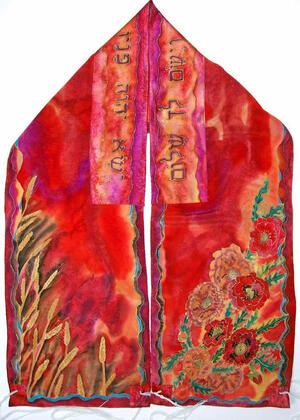Kavanah
I am, among many defining facets, a woman and a maker of tallit. A few days ago, I was gathering materials to write about the choices we make--to pray, to wear a beautiful prayer shawl, to leyn from the Torah, to actively weave ritual into our busy lives. While reading the Ha'aretz piece- “Police arrest woman for wearing prayer shawl at Western Wall (November 18, 2009)- which to a Reform Jewish woman in America is incomprehensible and archaic-- I received an email asking me to come hold a Torah for a photo in support of equal rights for women in Judaism. I was proud to do so.
As a Jew in the modern world, I tend to pick my way through the potential mine field of ancient directives, selecting the ones that I can accept, or at least strive for, stepping away from that which I can deem either historic or hyperbolic. I contend that many of us, although born Jewish, are Jews by choice, meaning that we choose how we integrate ritual into our lives. The phrase “time-bound” appears as a reason or non-reason for a woman to wear tallit, as if all humans are not bound by time. We choose to set aside time to pray, why not choose to wear a prayer shawl in which we can wrap ourselves in the past, wrestle with the present, and look to the future.
“What is your kavanah, your intention when you pray,” I ask each client. The answer, never quick, leads to spirited discussion. Many choose blessings seeking protection. For myself, I choose “May the words of my mouth and the meditations of my heart be acceptable to Adonai, my Rock and my Redeemer.” I could stop at “acceptable.” As one woman raised in the Workman’s Circle said to me of her own practice, “It’s about the striving.”
Donning my tallit helps me step into a quiet place where I can focus. Prayer and Torah study is about paying attention, looking for balance, fostering the gifts I was born with and that were nurtured by my parents, and being kind, and if not always kind, then at least understanding.
When my Russian-born grandfather was 18 years old, his two brothers, studying to be Torah scribes, were murdered by Cossacks. My grandfather, whom I never met, came to America and fathered three sons. My decision to become a designer and painter of prayer shawls, wedding canopies and healing headscarves is, in part, a way to say Kaddish for these family members and others each time I hand letter a prayer in Hebrew. Tallitot add more colors to my spiritual palette than I ever imagined.
Beth Surdut is an artist who designs and paints prayer shawls and more in Santa Fe, New Mexico. You can visit her website at www.bethsurdut.com.







Beth, thank you for sharing some of the impetus behind your very vibrant and meaningful tallitot. I particularly appreciate your comment about all of us being bound by time. We then choose how to pray (or not) within those constraints. Being beautifully held by a tallit - or by one's own imagination - certainly can support our prayers.
The translation of the Hebrew on this tallit, which is a gift from a 75-year-old woman to a dear friend she has known since college, is the third part of the priestly blessing-- "May Adonai lift up his face unto you and give you peace."